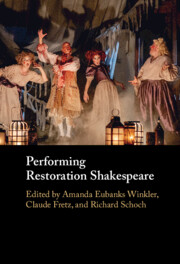Book contents
- Performing Restoration Shakespeare
- Performing Restoration Shakespeare
- Copyright page
- Contents
- Figures
- Tables
- Music Examples
- Notes on Contributors
- Foreword
- Acknowledgements
- Abbreviations
- Introduction: New Shakespeare for a New Era
- Chapter 1 From Boards to Books: The Circulation of Shakespearean Songs in Manuscript and Print during the Interregnum
- Chapter 2 Heroic Shakespeare at Lincoln’s Inn Fields
- Chapter 3 More than a Song and Dance? Identifying Matthew Locke’s Incidental Music for Macbeth
- Chapter 4 Cross-Dressing in Restoration Shakespeare: Twelfth Night and The Tempest
- Chapter 5 Performing Restoration Shakespeare in the Eighteenth Century
- Chapter 6 An Actor’s Perspective on Restoration Shakespeare
- Chapter 7 Staging Restoration Shakespeare with Restoration Music
- Chapter 8 Davenant’s Lady Macduff and the Subversion of Normative Femininity in Twenty-First-Century Performance
- Chapter 9 Facts as Ideas: The Theatricalisation of Scholarship
- Chapter 10 Syncopated Time: Staging the Restoration Tempest
- Bibliography
- Index
Chapter 1 - From Boards to Books: The Circulation of Shakespearean Songs in Manuscript and Print during the Interregnum
Published online by Cambridge University Press: 28 January 2023
- Performing Restoration Shakespeare
- Performing Restoration Shakespeare
- Copyright page
- Contents
- Figures
- Tables
- Music Examples
- Notes on Contributors
- Foreword
- Acknowledgements
- Abbreviations
- Introduction: New Shakespeare for a New Era
- Chapter 1 From Boards to Books: The Circulation of Shakespearean Songs in Manuscript and Print during the Interregnum
- Chapter 2 Heroic Shakespeare at Lincoln’s Inn Fields
- Chapter 3 More than a Song and Dance? Identifying Matthew Locke’s Incidental Music for Macbeth
- Chapter 4 Cross-Dressing in Restoration Shakespeare: Twelfth Night and The Tempest
- Chapter 5 Performing Restoration Shakespeare in the Eighteenth Century
- Chapter 6 An Actor’s Perspective on Restoration Shakespeare
- Chapter 7 Staging Restoration Shakespeare with Restoration Music
- Chapter 8 Davenant’s Lady Macduff and the Subversion of Normative Femininity in Twenty-First-Century Performance
- Chapter 9 Facts as Ideas: The Theatricalisation of Scholarship
- Chapter 10 Syncopated Time: Staging the Restoration Tempest
- Bibliography
- Index
Summary
The popularity of music in Restoration Shakespeare can be explained in part by the hitherto unacknowledged circulation of Shakespeare’s songs in print and manuscript during the Interregnum. It has often been assumed that the closure of the public theatres between 1642 and 1660 and the suppression of polyphonic church music caused seventeenth-century England to lag behind Europe musically. The Interregnum has therefore been side-lined by music and theatre historians in favour of the Restoration and its stimulating theatrical revival. While the cultural restrictions of the Civil War and Commonwealth inevitably impeded new theatrical works, a survey of the literature produced during the Interregnum confirms a continued interest in drama and dramatic song. The songs from Shakespeare’s original plays reached an all-time peak in their appearance in print during the mid-seventeenth century. The Wits, or, Sport upon sport reveals that during the closure of the theatres, excerpts from pre-war plays were performed privately. The diaries of Evelyn and Pepys indicate that recreational and domestic music-making flourished, and the distinction between professional and amateur musicians developed a fluidity that would persist into the Restoration. The irrepressible enthusiasm for dramatic songs fuelled the phenomenon that would come to be known as Restoration Shakespeare.
- Type
- Chapter
- Information
- Performing Restoration Shakespeare , pp. 15 - 37Publisher: Cambridge University PressPrint publication year: 2023



